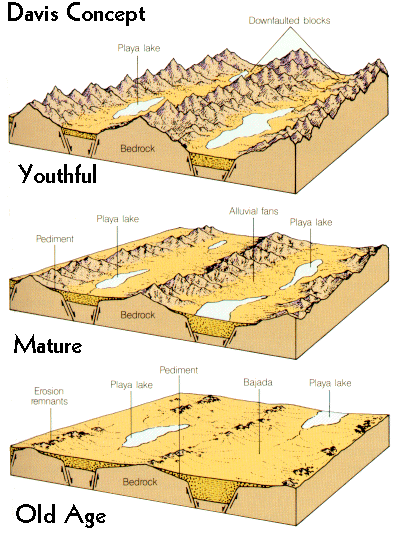|
1-cycle of erosion :
The geographic cycle or cycle of erosion is an idealized model that explains the development of relief in landscapes. The model starts with the erosion that follows uplift of land above a base level and ends – if conditions allow – in the formation of a peneplain. Landscapes that show evidence of more than one cycle of erosion are termed "polycyclical". The cycle of erosion and some of its associated concepts have, despite popularity, been a subject of much criticism.
2-William Morris Davis Model:

William Morris Davis, the originator of the model, divided it into stages whose transition is gradual. The model begins with an uplifted or to-be-uplifted landscape. Then Davis defined a youthful stage where river incision(नदी चीरा) is the dominant process shaping the landscape. During the youthful stage height differences between uplands and valley bottoms increase rapidly. The youthful stage is followed by a mature stage where height differences between valley bottoms and uplands are at their greatest. Beginning in the mature stage slope decline becomes a more important phenomenon, and uplands lose height more rapidly than rivers incise, effectively diminishing relief. In the very latest stage erosion has acted so long that the landscape – despite original height – is reduced into a rolling lowland. This landscape of low relief is called a peneplain and may contain residual heights standing out from the general level. The peneplain can be uplifted, starting a second erosion cycle

3-Early acclaim and criticism of Davis Model:
Davis conceived the cycle of erosion model in the 1880s.More fully developed by 1900 it received wide acclaim, but was never universally accepted.The initial enthusiasm and strength of the cycle of erosion model has been attributed to various causes.
First, the model provided a framework to study areas and epochs in Earth history where erosion is the dominant process. Second, the model fitted well into the grand evolutionary thought that had emerged in the 19th century with Darwin's evolution theory
The notions of time, uplift, slope and drainage density evolution in the erosion cycle have been criticized. This criticism has been called "Davis bashing" by Cliff Ollier.
|
Variants of the cycle of erosion
|
|
Environment
|
Proposed by
|
Details
|
|
Arid
|
Davis,1905
|
At the beginning of the cycle of erosion in arid climate there are numerous small basins to where material is washed during the scarce rainfall events.
In the next stage (youthful stage) valleys are developed and highlands dissected by these.
Gentle slopes and basins accumulated material derived from the highlands. In the mature stage drainage basins coalesce.
At the end a stage is reached where the terrain has lost much of its relief and deflation hollows interfere with the drainage systems, breaking it up into local systems. During all stages sand and dust might be exported by wind to other landscapes.
|
|
Coastal
|
Johnson, 1919
|
Alternate models are proposed for shore profiles: one for shore profiles of emergence and another for shore profiles of submergence.
A complementary model can be applied to shore lines where different parts might have undergone submergence and emergence.
|
|
Glacial
|
Davis, 1900
|
The glacial cycle of erosion deals with mountainous regions and lacks an old stage since Davis argues that nothing more developed than mature glacial landscapes exists at present.
Over time valley glaciers erode the underlying rock at different rates, creating valleys and glaciers that are more entrenched than others.
As time passes the less-entrenched glaciers reach the same levels of entrenchment as the more entrenched ones, since the deeper a glacier erodes, its erosive power diminishes.
In a mature stage, valleys form smooth-sided troughs.
|
|
Karst
|
Cvijic, 1918
|
The cycle of erosion in karst regions has three phases.
At first the upper parts of fractures are dissolved, enlarged and filled with water. Normal fluvial valleys develop on the surface, small polies might exist. Subsequently, re-routing of water by the growth of a karst system disorganizes the fluvial drainage pattern, with valley bottoms developing large dolines and uvalas.
Ridges between uvalas gradually disappear as these landforms coalesce. If the bedrock is underlain by insoluble rock, normal fluvial valleys will slowly re-appear once the underground river systems reach the insoluble rock. In the end soluble rocks appear only as isolated hills.
Contrary to Davis' original cycle of erosion the karst one does not end in the formation of a peneplain.
|
|
Periglacial
|
Peltier, 1950
|
The periglacial cycle of erosion begins with a non-periglaciated landscape. Once-periglaciated mass wasting of regolith exposes bedrock in the upper slopes.
These outcrops are then subject to frost weathering that makes slopes retreat forming extensive blockfields at the base of the bedrock areas. At a later stage solifluction wears down summits and fills in topographic lows.
|

|
Evolution of Thought Toward Landscape Evolution
|
|
Davis Cycle-3 Stages of Landform Development
|
Current Thought
|
|
1-youthful
2-maturity
3-old age
|
1-tectonism causes uplift
2-isostasy
3-climate modifies
|
|


